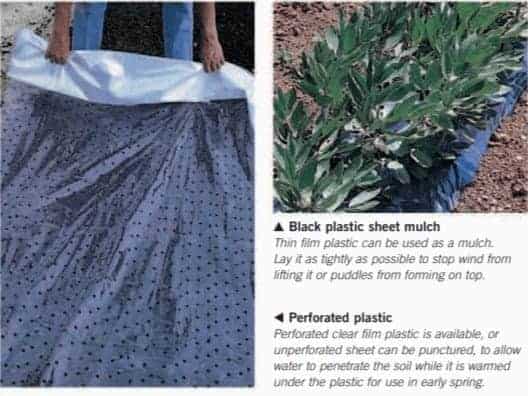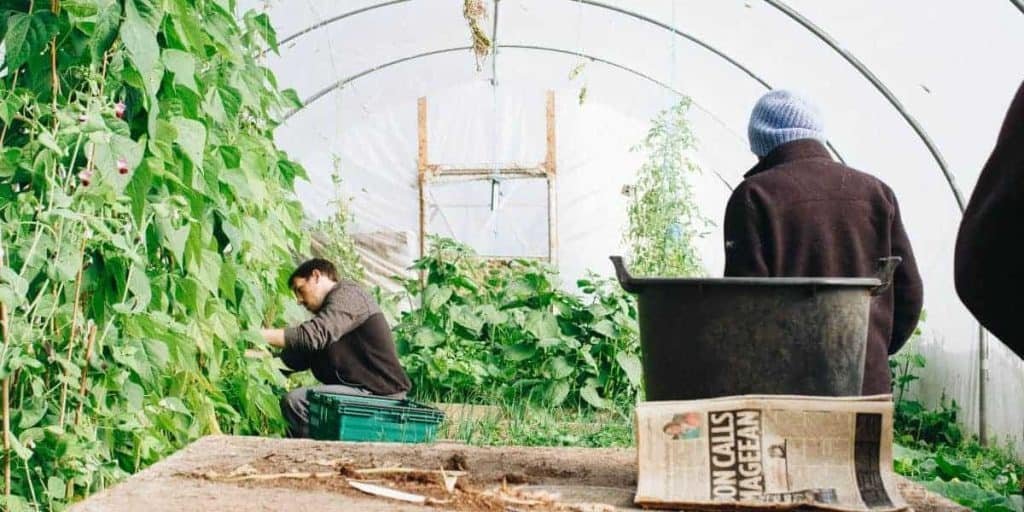Mulching 101
Mulching is the process of covering the soil surface with a layer of organic or inorganic material. It is one of the most useful gardening practices, which can bring significant improvements in cultivation of fruits and vegetables.
The benefits of mulching cannot be overemphasized, and it is a technique not sufficiently appreciated and used. Mulching should feature in the plans and maintenance of any size of kitchen garden; it will save labor and result in better quality and yield. There is a wide choice of methods, so mulches can be used by anyone, in any size of garden.
THE BENEFITS OF MULCHING
All crops require continuous supplies of water, and mulching helps this in two ways. Any type of mulch provides a seal, reducing evaporation from the soil: this is particularly beneficial during warm or windy weather when large quantities of water are lost in this way. Organic mulches also help moisture retention by improving soil structure and fertility as they are drawn down into the surface layer by earthworms.
A mulch can also protect soil structure from being damaged by heavy rain. Mulches can enhance or maintain soil temperature. A mulch reduces heat loss as air temperature falls: this can keep plant growth active and in many cases prevent physical damage to parts below ground, such as mature carrot roots.
A clear plastic sheet mulch applied before sowing raises soil temperature, encouraging germination and early growth. Most other types of mulch keep the ground relatively cool during summer: this reduces water loss and also maintains good conditions for the beneficial soil-inhabiting organisms.
These advantages apply to fruit plants as much as vegetables. Mulching around fruit trees and bushes can have a dramatic effect on growth, easily confirmed by leaving a plant or two untreated. Covering the soil with a mulch of almost any sort will reduce germinating weeds by depriving them of light.
Short-term coverings suppress annual weeds; to control perennial weeds, mulches such as heavy gauge black plastic or thick carpet should be put in place for a long time, well in advance of cropping. If annual weeds do grow through mulches they are invariably weak-rooted and easily pulled out.
ORGANIC MULCHES
Most bulky organic manures can be used for mulching, providing they are well decomposed through weathering. Garden compost and leaf mold are ideal, as well as spent mushroom compost. Shredded prunings, bark chips, and weathered sawdust are effective, but add supplementary dressings of nitrogenrich fertilizer, for the soil may become deficient in this as the products are broken down.
Cocoa shell is available for use as a mulch; it is relatively costly and its smell may attract animals. Straw is especially good around strawberries or over rhubarb beds. In coastal areas, seaweed may be available, but check that gathering it is permitted.
Organic mulches must be kept aerated and free-draining: for this reason do not put thick layers of grass clippings around plants as a mulch, because they become slimy and compacted. Some gardeners use old carpet and cardboard or newspapers for mulching. Each is effective, but unsightly.
INORGANIC MULCHES
Film plastic is the most commonly used inorganic mulching material. Clear plastic is most effective for raising soil temperatures, but because it lets light through it not only allows but also actually encourages weed growth. It is useful for warming and protecting a seedbed under preparation, and if carefully managed it can also be used as a floating mulch for the first few weeks after sowing.
Use black film plastic for longer-term cover. It suppresses weeds, conserves moisture, and is useful for keeping fruits and vegetables off the soil surface. Heavier grades of plastic sheet are less likely to tear and will last for more than one season, especially where made with a sunlight-inhibiting ingredient. Old fertilizer or compost sacks can be cut to form covers for use around trees.
Film plastics that are white or silver on one side and black on the other are very useful: with the black side downward they reflect light up into the plants. These are more expensive, and probably most justified where crops are grown under protection.
All-white plastic gives similar benefits. Some heavy-gauge woven plastic sheets can be found, made for longterm mulching such as around fruit bushes and trees or for pathways, where they are an economic investment.
Decorative stone chips are possible candidates for some situations, especially around wall fruits. Such cover brings significant rise in soil temperature. Another less obvious form of mulching is provided by shallow hoeing of the soil surface, which in effect produces a separate dust layer to aid moisture conservation.
DISADVANTAGES OF MULCHING
Mulching has a few potential pitfalls. Organic kinds can encourage disease if layered heavily right up to the necks of plants. Fresh animal wastes can cause damage to plants through high levels of ammonia. More inert organic materials, like wood derivatives, can deplete the soil of nitrogen as they decompose. Some materials may be unsightly or troublesome by being scattered by foraging birds.
All mulches provide refuge for slugs and some types similarly for snails and even small animal pests like voles. Most film plastics are impervious to rain or irrigation and may require watering lines laid beneath. None of these problems cannot be dealt with.
The important thing is be aware of them and be watchful about methods of mulch application and of methods of pest control where appropriate.
APPLYING MULCHES
Apply all mulches to soil that is neither very wet nor very dry: a mulch will only serve to exacerbate both these conditions. Spring application is valuable because the conservation of soil moisture encourages early growth and suppresses the first flushes of annual weeds.
Mulch fruit plants immediately after planting, and put straw around strawberries just as young fruit trusses are enlarging. Mulch vegetable rows as soon as the plants are well established. Mulch in the fall to top off earlier applications as a soil improver or provide frost protection to root crops.
Mulches of garden compost, leaf mold, or manure must be of friable texture. Apply to a depth of 1–3in (2.5–8cm). Straw and hay around robust plants may be twice as deep, allowing for settlement. Fix all plastic sheet mulches as tightly as possible, and lay during a warm, sunny period, when the material will be flexible. The soil surface should be flat, so that water will not collect in puddles on the sheet.
Push the edges of the sheet into the ground with a shovel, making a deep slit in the soil beforehand. Ensure the sheet is removed as soon as its useful life is over, as it can shatter on degrading.
Organic mulches are absorbed into the soil so do not need to be removed. Mulching has a practical place for covering pathways, too, not only to control weed growth but also to give a safe, clean walking surface.
Originally posted 2020-07-29 20:36:02.






